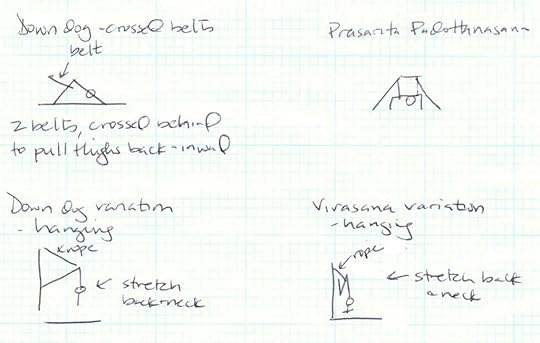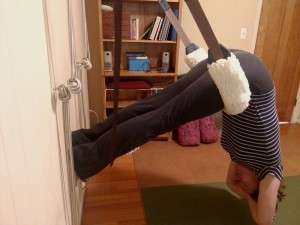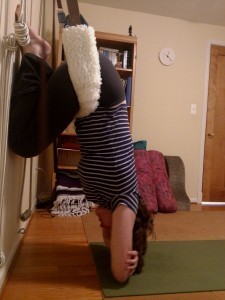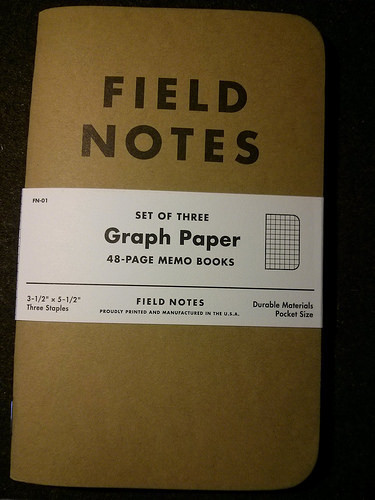Dunrie Greiling's Blog, page 6
February 9, 2015
Customer Service: A Name, My Name, is Important
I have a difficult name – the first and the last names are unfamiliar. I haven’t met another Dunrie, and the only Greilings I have ever met are relations. People mess up the spelling, they don’t know how to hear it, they think Dunrie is my last name a lot and ask for my first name.
I’ve developed a few patterns to try to avoid certain common misconceptions about my name. It’s often misheard as “Dumrie” instead of Dunrie, so when I spell it out, I often say “N as in Nancy.”
Well, I went to a neighborhood coffee shop last week, after the morning rush. I was the only person in line and the cashier (who, I believe, is also the owner) asked me my name to keep with the order. She started to write “D U” on the slip, and then when she heard “N as in Nancy” she crossed off the D and the U and said, “I’ll put it under Nancy.”

I like tea. I also like my actual name.
What I should have said was, please don’t. People have special sense for their name. I would have heard Dunrie when the barista called it into the noisy coffee shop. I had to listen for Nancy. Besides, there was no one behind me, so I’m not sure what the personal or professional loss would have been to attend to the last four letters of my actual name.
What did I say? Nothing. I moved along, listened for “Nancy” and took Nancy’s fancy tea latte. I felt cross and misunderstood. Efficiency 1; Customer Service 0.
It’s a Dale Carnegie truism that almost nothing is more melodious to a person than her name. Maybe the shop owner was having a bad or busy moment that wasn’t obvious to me. Yet, it’s hard to make me feel more unwelcome in your shop than refusing to get my name right.
The post appeared first on Scientific Ink.
February 2, 2015
Next-Generation Goals
I’ve been swimming to get my cardio and to strengthen and stretch.
I used to swim laps for exercise in college and grad school, and I got back to it in the last few years as a way to work on my back and get in better shape. When I started swimming laps again, I gave myself a goal of swimming continuously for a certain number of minutes.

Laps, made available via Creative Commons by maxtm on flickr
I worked up to 20 minutes. In the beginning, it was a good enough goal. It kept me swimming through the time when a single lap would wind me and I’d have to swim a lap, then rest for a bit, then do it all again. Eventually, swimming for a set time just got boring.
Swimming laps to reach a particular time goal turned into a clock-watching exercise. I was counting down until it was over.
Am I done yet? Nope. Am I done yet? Nope. Am I done now? Argh, no.
Distance, not Time
I asked a friend what she swims, and she gave me a distance instead of a time. I knew I wanted to increase my effort, and setting a distance goal seemed like a great way to reset my mindset. Instead of counting down the seconds, I could instead count up the laps, feeling an increasing sense of accomplishment rather than waiting to be dismissed.
When swimming for distance, if I want to get it done more quickly, I have to increase my effort. There’s an incentive to try rather than coast.
This simple goal shift reinvigorated my practice – I extended the time I’m in the pool and increased the fun. Now if only I could count laps without losing track…(I am currently refusing the purchase an electronic lap timer watch or ring. Right now I count by moving a flip flop around like the hour hand on a clock.)
Part II: Expand the Concept of Distance Beyond a Single Workout
I was thrilled to see the Pool Challenge at my Fitness Center. They provided three options for swimming or running between February and the end of 2015.
Swim to Lansing: 64 miles
Swim the length of the Huron River: 93.5 miles or 3366 laps
Swim the distance of the Port Huron to Mackinac race: 235 miles.
I did the math, and the Huron River is within reach. I know committing to swim the length of the Huron River will get me to the pool more often, and I’ll feel better and be happier with myself as a result.

The Huron River on a still winter morning.
Postscript:
Although I never swam competitively, the urge is in my genes. Family legend has it that grandmother tried out for the Olympic team in her youth, which would have been in the late 1920s or early 1930s. I hope that story is true. I imagine her in one of those modest old-time swimsuits, tweaking tradition as a female athlete. I never met her, and this is one of many stories I would have loved to hear from her.
The post Next-Generation Goals appeared first on Scientific Ink.
December 28, 2014
Uncertainty as a superpower
Webstock ’14: Liz Danzico – The Fringe Benefits of Quitting from Webstock on Vimeo.
Themes for me:
Creativity lives within uncertainty.
What will you leave behind to find your next big thing?
Entrepreneurs are not necessarily those who doggedly pursue a single idea, sometimes they adjust course and flex.
Found this video via Rands in Repose.
The post Uncertainty as a superpower appeared first on Scientific Ink.
November 12, 2014
Lesson learned, again, data is helpful
A little data is a beautiful thing.

Nested archways on the beautiful Princeton University campus, made available via creative commons by Rob Shenk on Flickr
I’ve been on the Board of Directors of the Princeton Club of Michigan for the last several years. Although I live in Ann Arbor, I’ve traveled to Birmingham, Novi, Detroit, and elsewhere for meetings. In my time on the board, we have not held an event in the Ann Arbor area.
Well, the Princeton Alumni Council shared some basic demographics about the club with us. It turns out that about one-third of all Princeton University alumni in Michigan are here in Ann Arbor.
So, we planned a happy hour right before Halloween in downtown Ann Arbor. Halloween is also the best time to wear orange and black Princeton gear.
We were pleased with the attendance, and it could not have been easier for me to attend. I didn’t have to cross I-275 or take 696. I just had to dig out my orange beer jacket and find a place to park downtown.
For a membership organization, locating events near our membership helps encourage attendance. It sounds like a “duh” but because most of the leadership was from the Birmingham area…that’s where we put most of our events. We just didn’t have the data and were basing our decisions on habit and our personal preferences. Hard data helps decision-making.
Ever wondered why the theme color of this blog is orange? Now you know ;).
The post Lesson learned, again, data is helpful appeared first on Scientific Ink.

November 3, 2014
Yoga retreat in Sonoma – hip relief for my Scoliosis
I have been a “distant student” of Elise Browning Miller’s for years. She teaches Iyengar yoga, with a keen sense of how to adjust to accommodate for and unwind scoliosis.
She is based in the Bay Area, and Elise travels the continent teaching yoga for back care and yoga for scoliosis. I have traveled to Kalamazoo, Chicago, Cleveland, and California to learn from Elise. Every year, she hosts a retreat in northern California.
Her retreat in California is my favorite by far. For the other locations, she’s teaching at a local yoga studio, and the class is made up of local students, local teachers, and a few travelers. So, when I have traveled in the midwest, it has been yoga class and then solo meals and a basic hotel. At Westerbeke, everyone travels and stays over (even from the Bay Area). So there’s a community outside the classes, and the location and the food is wonderful.
It was as if my back gave up 50-weeks since I last saw Elise. It was as if it said “I got you most of the way, now get me to the teacher who can help you do better by me!” I had strong, debilitating pain in my left hip/lower back. I couldn’t sit at the computer. I preferred to stand or to lie back in a mild backbend on all of my yoga bolsters. I could get some relief by digging my fist into my back and glutes. I dreaded sitting on the plane, but I knew I’d get better in class.
As usual, the classes completely erased my pain. I appreciated the sequencing of the poses and the hands-on help – pulling me this way or that way. I learned I still need to pay attention to derotating my spine – particularly lifting my concave left side in certain poses.
What I learned
At one point, I spoke with Elise about my lingering lower back/hip issues. The hip/SI joint that has been really bothering me is the one opposite my scoliosis. I have right-thoracic curve, and it is my left hip that is problematic. She suggested I consider including the following five asanas in my practice.
These five asanas have helped me maintain the pain-free and happy state I attained during the retreat.

Quick sketch of four of the five poses for relief of hip pain in scoliosis.
Down Dog with crossed ropes or straps
Here is a video of Elise teaching Downward Facing Dog with crossed ropes from a doorknob. I use ropes attached to eye hook sunk into the wall by a professional carpenter.
Prasarita Padottanasana – Wide-legged pose
Prasarita Padottanasana video and instructions available at Yoga Journal website.
Down Dog variation from yoga swing
The head and arms are not touching the floor, so gravity is giving me a gentle pull downwards to stretch my back.
I’m also getting a nice pull upwards on my thighs from the swing.

A down-dog-like pose hanging from a yoga swing.
Virasana – hanging from the yoga swing
I get a good stretch of the back (note – neither my head or arms are touching the floor, so gravity is giving me a nice and gentle pull downwards). I feel a lot more of the swing’s pull on my tricky hip, making me think it is a little out of alignment. So, the swing is helping there too.

Hanging from a yoga swing in a version of Hero’s Pose – Virasana
Supta Padangustasana – with double belts
Here’s a video of Elise teaching how to use the second belt to really get good traction in this pose. This setup helps me to lengthen rather than bunch up the hip of my “up” leg. If I only had time to do one asana, this is the one I would do.
Note: Elise’s voice is faint during this video, turn your volume up and then don’t forget to turn it back down at the end.
Since adding these yoga asanas to my routine, I have felt increasing well-being in my lower back and quietness in my body. My scoliosis affects me, but if it helps me keep up with my yoga, well then it helps me be healthy.
Learn More from Elise
Elise’s DVD has been a huge help in my learning and adjusting for my scoliosis.
The post Yoga retreat in Sonoma – hip relief for my Scoliosis appeared first on Scientific Ink.

October 24, 2014
Good product placement works – discovering I love Field Notes

To Sell is Human Cover
In late 2012, I pre-ordered Daniel Pink’s book To Sell is Human. One of a set of five gifts/thank yous for pre-ordering was a Field Notes memo book, stamped with To Sell is Human on the back.
I read To Sell is Human, and I used the memo book. I am a journal keeper, and I like Moleskine journals (among others). I like to take my journal from start to finish, and I resist starting other notebook-y things and diffusing my writing efforts.
As a consequence, I haven’t always known what to do with little memo books, and yet I found a use for this one. I carried it in my purse. It served me well at those times I needed to jot something down on the run – especially when taking out my phone to add a task/send a message would have been awkward.
I use it differently than my journal. The memo book is a temporary holding place. It’s kind of like a written RAM that gets cleared away. I won’t keep the old one, and I keep journals forever.

My new Field Notes pack!
Daniel Pink’s cobranding/partnership/product-placement/whatever-it-was worked. Now I’m hooked on Field Notes’ graph-ruled memo books. I just received my re-up, this time I chose the kraft paper cover.
And I think of Daniel Pink and how we’re all in sales every time I reach for it, even though “To Sell is Human” is not stamped on the back of this one.
The post Good product placement works – discovering I love Field Notes appeared first on Scientific Ink.

October 14, 2014
Knausgaard reading from My Struggle
“The deeper you go inside, the more general a place you reach.”
Yes.
I read My Struggle Book 1 and now am 3/4 of the way through Book 2. I am loving these books and his writing. His description of the mundane and his internal monologue is riveting, addictive, and moving. Listen to his own reading of his work and see for yourself.
 My Struggle: Book 1 by Karl Ove Knausgård
My Struggle: Book 1 by Karl Ove Knausgård
My rating: 5 of 5 stars
The post Knausgaard reading from My Struggle appeared first on Scientific Ink.

September 29, 2014
Orient by water
I orient by water. Apparently I have to keep it on the east. If I don’t I have a hard time finding my way around the land. This is one of the many reasons I don’t live in California.
I grew up on the east side of Michigan, in a town pressed up against Lake Saint Clair. Lake Saint Clair is part of the Great Lakes, it’s just not a great lake, more like a pool in between the two straits that connect Lake Huron with Lake Erie.
My family has a cottage up on the east side of the Bruce Peninsula, the Peninsula defines Georgian Bay stretching off to the east.
I spent a lot of time on the east side of south Florida. There again, the seemingly limitless Atlantic stretches off to the East.
And I went to school in New Jersey – once more on the eastern side of the continent.
Basically, all of my most familiar and beloved places have had “big water” to my east, and even when it hasn’t been in sight, I’ve known it was there.
When I go to a place like California that has its ocean to the west, I get my cardinal directions completely backwards, and I find myself stumbling over the fact that away from the water is indeed East, not West, when driving and planning routes. I have imprinted my mental maps on the entirely subjective assumption that the “big water is to the East”.

The clear, cold water of Georgian Bay, which I like to keep to the East of me.
Learning about my own mental shortcuts helps me see that the categories I create about the world aren’t the world.
The post Orient by water appeared first on Scientific Ink.

September 26, 2014
Margaret Atwood on writing perceptions
I’m pondering the intricacies of nonfiction and fiction writing and interpretation. I heard this on the radio and recognized its truth immediately.
When you’re writing fiction, everybody thinks you’re secretly writing about real people and things. But if you write an autobiography, they think you’re lying as one does.
From Margaret Atwood’s interview with Arun Rath on NPR books, interview full text available from WFAE’s website.
The post Margaret Atwood on writing perceptions appeared first on Scientific Ink.

September 17, 2014
Electronic music on repeat: Dawn of Midi and the xx
I go through audio obsessions.
Last fall, I listened to Dawn of Midi‘s Dysnomia on repeat as I drove, as I wrote, as I cooked. I found it via the RadioLab podcast. I loved the sense of driving seemingly-electronic music slowly morphing, and I loved to hear that it wasn’t electronic at all, but humans playing to sound like machines. The layering of sound and story was what caught me, but the music kept me.
This summer and fall, I’ve been listening to the xx‘s two releases on repeat. I discovered them via the New Yorker’s profile, Shy and Mighty.
Two different artists and sounds, but both triggered my play daily on repeat response and I thought I’d share. Both are good as foreground or background, which is a hard thing to do.
I know making music and getting paid for it these days is tough going, so if you like these songs, go support the artists and buy their music!
The post Electronic music on repeat: Dawn of Midi and the xx appeared first on Scientific Ink.




